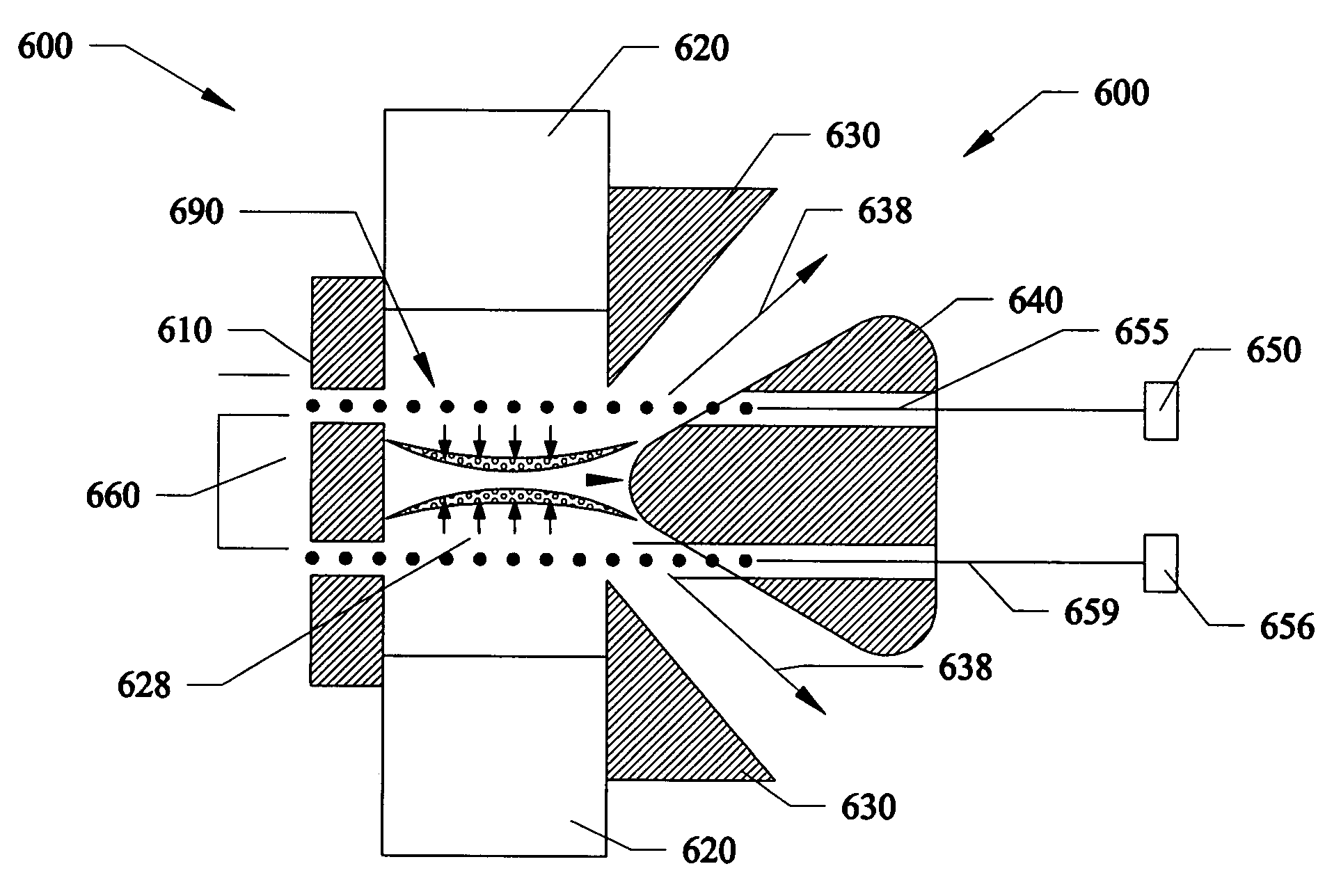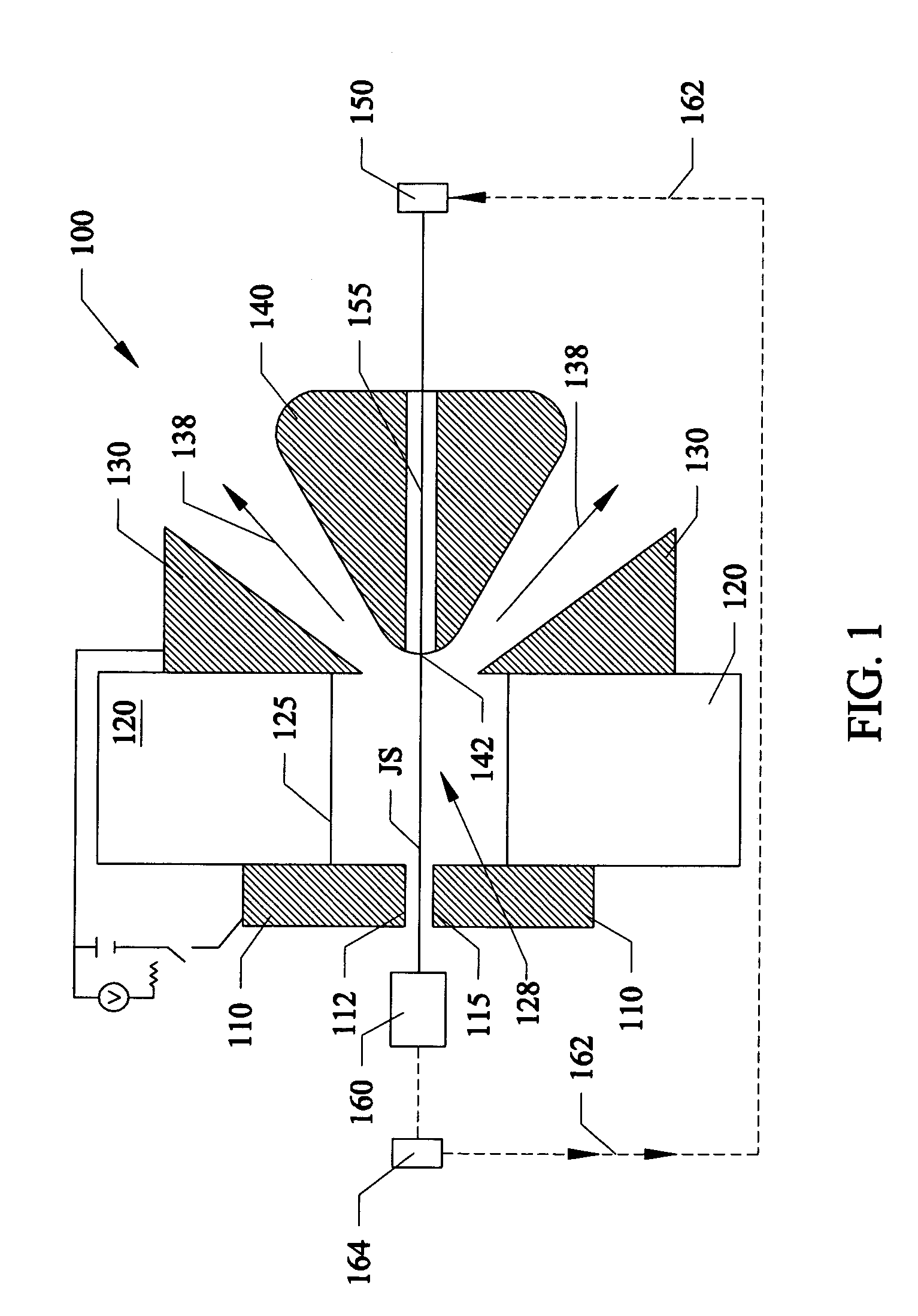Liquid-jet/liquid droplet initiated plasma discharge for generating useful plasma radiation
a plasma radiation and liquid droplet technology, applied in the field of plasma discharge radiation sources, can solve the problems of limited lifespan of sources, and reducing the operating lifespan of these sources, so as to reduce damage to related optic components
- Summary
- Abstract
- Description
- Claims
- Application Information
AI Technical Summary
Benefits of technology
Problems solved by technology
Method used
Image
Examples
first preferred embodiment
[0027]FIG. 1 shows a cross-sectional view of a first preferred embodiment 100 of an inertially confined liquid jet discharge source. 110 refers to electrodes having a space 115 formed there between. An electrode 110, such as a metal electrode can function as an anode, and be to one side of an insulator 120, such as an electrically insulating or partially insulating insulator such as but not limited to an insulating material such as rubber, a ceramic, glass, and the like. On the opposite side of the insulator 120 can be a second electrode 130–140, such as a metal electrode that can function as a cathode. Either electrode 110, 130 / 140 can also function as an emitter or collector of the liquid jet. Electrode portion 140 can function like a debris blocker similar to those described in U.S. Pat. No. 6,232,613 to the same assignee as that of the subject invention, which is incorporated by reference. Liquid jet stream generating device 150 can be a pressurized metal or insulative liquid re...
second preferred embodiment
[0041]FIG. 2 shows a cross-sectional view of a second preferred embodiment 200 of a liquid jet pinch plasma discharge source with a cylindrical variant 228. Electrode (Anode) 210, insulator 220, electrode (cathode) 230, 240, and receptical 260 can be identical to the similarly labeled components in the embodiment of FIG. 1. In FIG. 2, there can be two or more liquid jet stream generating devices 250, 256, and two or more liquid jet injectors 255, 259 each similar to the liquid jet generating device (reservoir) 150, and jet injector 155 shown and described in FIG. 1. Alternatively, several liquid jet injectors can be run from a common liquid jet stream generating device.
[0042]The liquid jet injectors 255, 259 can be used to generate a continuous conductive liquid jet stream which provides a current path. In essence the current will run through the jet stream.
[0043]The functional description of all components of the source 200 in FIG. 2 can be identical to that those shown in FIG. 1. ...
third preferred embodiment
[0045]FIG. 3 shows a cross-sectional view of third preferred embodiment 300 of a jet pinch plasma discharge with a conical variant. Electrode (Anode) 310, insulator 320, electrode (cathode) 330 / 340, liquid jet steam generating devices 350, 356, liquid jet injectors 355, 359, and receptical 360 are each similar to the similarly labeled components in the preceeding embodiments.
[0046]Similar to the previous embodiments, the injectors 355, 359 can be used to generate a continuous conductive liquid jet stream which provides a current path.
[0047]The functional description of all the components in FIG. 3 are identical to those shown in FIG. 1. The function of the cylindrical sets of jets is the same as in the second embodiment (FIG. 2), except that the cylindrical plasma sheath is now a (slightly) conical plasma sheath. This slightly conical plasma sheath can be produced by a conical array of jet assemblies and receptical(s). The compressing sheath plasma can converge on itself in the same...
PUM
 Login to View More
Login to View More Abstract
Description
Claims
Application Information
 Login to View More
Login to View More - R&D
- Intellectual Property
- Life Sciences
- Materials
- Tech Scout
- Unparalleled Data Quality
- Higher Quality Content
- 60% Fewer Hallucinations
Browse by: Latest US Patents, China's latest patents, Technical Efficacy Thesaurus, Application Domain, Technology Topic, Popular Technical Reports.
© 2025 PatSnap. All rights reserved.Legal|Privacy policy|Modern Slavery Act Transparency Statement|Sitemap|About US| Contact US: help@patsnap.com



